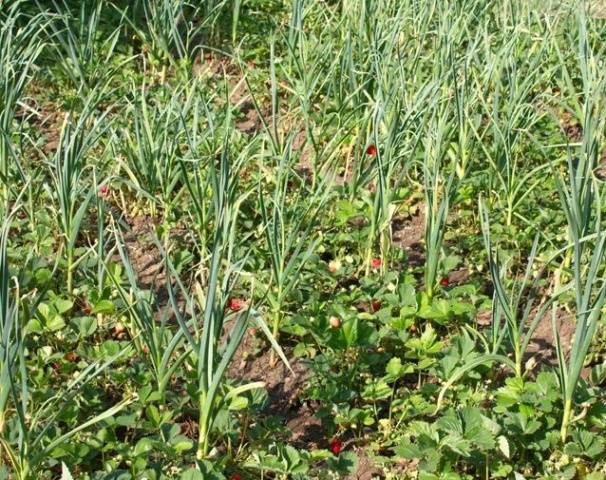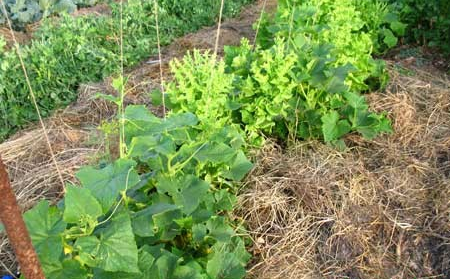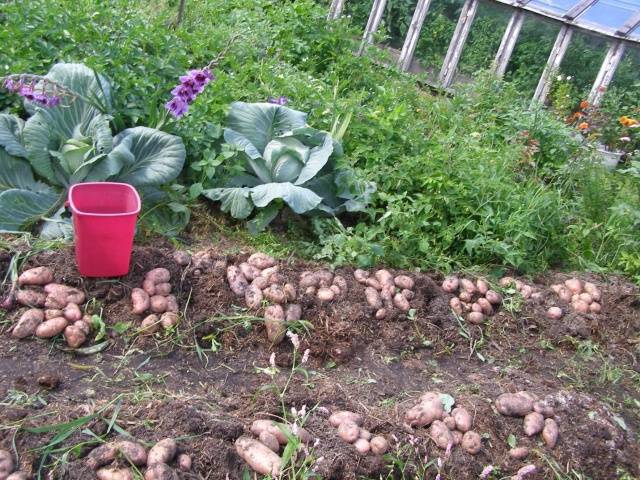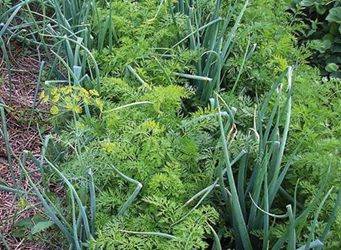Content
You can make your garden beautiful and at the same time make the most of every piece of land with the help of mixed beds. The technology involves planting several types of plants on one ridge. The neighborhood of vegetables in the beds can help protect plants from harmful viruses and insects. Also, combinations of some plants accelerate the growth of each other. At the same time, there are incompatible cultures that cannot be placed in close proximity. Given such conflicting facts, the creation of mixed beds should be approached competently, in order not to harm the plants, but to improve their growing conditions.
Technology advantages
Mixed planting vegetables in the garden have a number of advantages over isolated cultivation of crops:
- the area of the land plot is used as efficiently as possible;
- plants that feed on excellent microelements evenly deplete the soil, not competing with each other;
- neighbors in the garden can improve each other's taste;
- aromas emitted by certain plants can attract or scare away insects;
- the correct arrangement of plants can perform wind protection and create a favorable microclimate for growing specific crops;
- mixed cultivation of vegetables eliminates the use of chemical fertilizers, using only the natural forces of the earth to obtain a good harvest.
Thus, mixed beds are an easy way to improve yields. With the help of this technology, it is possible to competently use the land resources and, without the use of additional funds, attract beneficial pollinating insects, scare off pests and create the necessary microclimatic conditions.
Principles for the formation of mixed ridges
When forming mixed beds, the following principles should be strictly observed:
- in the central part of the mixed bed, it is recommended to grow crops with a long ripening period;
- the edges of the ridge should be used for growing short, rapidly maturing crops, for example, lettuce, spinach;
- when combining plants, it is necessary to take into account the development of their roots. So, in the immediate vicinity, you can plant crops with a strongly and underdeveloped root system;
- in mixed cultivation, incompatible crops should be planted as far apart as possible.
Having decided to create mixed beds in your garden, you should follow the above growing principles and carefully familiarize yourself with the properties of various crops. It should be remembered that the technology allows you to plant flowers and vegetables at the same time on the same bed. So, flower plants can not only have a beneficial effect on vegetable crops, but also make the garden even more beautiful.
Useful properties of plants
In close proximity to plants requiring pollination, it is recommended to plant crops that attract pollinators. These include various varieties of mint, marjoram, chamomile, thyme, lemon balm. These plants are not vegetables, but can be used for medicinal purposes or as garden decoration. Their scent attracts wasps and predatory flies, which pollinate flowering plants.
Heavy soils require constant loosening. In this case, earthworms can come to the aid of the farmer. To attract them, you can plant onions, chicory, valerian.
Garlic helps fight aphids. Its smell repels these harmful insects.Garlic also contributes to the accumulation of sulfur in the soil.
Combinations of vegetables
When creating mixed beds of vegetables, you should carefully select "neighbors" who will not harm each other, but will provide mutual assistance. The properties of most crops are individual, therefore, when creating complex plantings, each plant should be considered separately:
Tomatoes
It is recommended to grow garlic, bush low-growing beans, cabbage, carrots, beets, spinach, parsley in the immediate vicinity of tomatoes. Herbs with a particularly pronounced aroma (thyme, lemon balm, basil) repel pests, improve the taste of tomatoes and extend their shelf life.
It is not recommended to grow cucumbers, dill, fennel and potatoes near tomatoes.
Cucumbers
Cucumbers go well in the beds with various types of beans, beans, lettuce, onions, cabbage, dill, beets, celery. Tomatoes are perhaps the only crop that should not be planted next to cucumbers.
Wonderful neighbor for cucumbers is a radish. It scares off spider mites and leaf beetles. At the same time, the radish improves the taste of the crop. It is also worth noting that the proximity of cucumbers with onions is mutually beneficial.
Cabbage
Cabbage is often attacked by harmful insects. So, white clover can help in the fight against caterpillars. It is sown directly under the root of the cabbage. White clover also repels cabbage aphids and root flies. Celery helps to fight the earthen flea when growing cabbage. Herbs with strong, bright aromas scare away cabbage butterflies. Leeks will keep the scoop caterpillars from damaging your crops. Dill has a double beneficial effect on cabbage: it repels aphids and improves the taste of the vegetable.
Potatoes, beans, lettuce, beets can grow in the neighborhood of cabbage without causing harm. Tomatoes, grapes, garlic should not be planted on a mixed bed with cabbage.
Potatoes
Potatoes are often planted as a stand-alone crop, however, suitable healthy neighbors can also be found for them. So, horseradish can protect potatoes from bedbugs, and legumes bring nitrogen into the soil, which has a beneficial effect on potato productivity. Also, legumes protect potatoes from the Colorado potato beetle.
Harmless neighbors for cabbage on a mixed bed are salads, radishes, corn, coriander. It is not recommended to grow beets, sunflowers and tomatoes near potatoes.
Bow
The combination of carrots and onions is a classic for our gardens. These two plants in the same garden scare off pests, their roots do not compete. In addition to carrots, beets, cucumbers, radishes, spinach, lettuce are well suited for the neighborhood with onions. It is not recommended to plant beans, beans, peas on the same bed with onions.
Other vegetable crops can also be used to create mixed beds. So, for example, garlic feels good on a strawberry garden. And although garlic does not have a particular effect on the berry crop, this combination of plants allows the rational use of land areas.
Mint, radish and legumes can speed up the growth and maturation of zucchini. It is recommended to plant eggplants in mixed beds in combination with beans, basil or peas. The empty space between the rows of beets can be filled with green salad, which will be a great neighbor. Information on compatibility of other vegetable crops can be found in the table below.
It is, of course, difficult for novice gardeners to navigate the whole variety of vegetable crops and select schemes for creating mixed beds. That is why experienced farmers offer certain schemes for planting plants on mixed ridges. Here are some of them:
- Lettuce should be planted on the first, extreme row of the ridge.The second row can be planted with radishes or carrots, the combination of these root crops in one row is also welcome. On the third row of such a mixed bed, onions should be planted. The fourth and fifth row of the bed should repeat the second and first, respectively.
- In the middle of the garden it is necessary to plant cucumbers. One edge of such a mixed bed is allocated for growing beans, the other for cabbage.
- It is rational to alternate carrots with onions or marjoram so that there is a distance of 30-35 cm between the rows of carrots.
You can get acquainted with some other schemes for planting vegetable plants on mixed beds by watching the video:
Useful herbs
It is generally accepted that only useful plants that are a food product should be grown in the garden. However, few people know that some herbs, flowers and even weeds can be beneficial in the garden:
- thyme next to onions can significantly increase its yield;
- geranium, petunia and marjoram can not only decorate the garden with growing bell peppers, but also improve the yield of the crop;
- next to carrots and legumes, you can plant rosemary and sage;
- different types of lettuce can improve the taste of tomatoes growing in the neighborhood;
- the root system of dandelions goes deep into the ground, raising calcium to the surface of the earth. Dandelion flowers also attract pollinating insects;
- marigolds are able to decorate the beds with any vegetable plants, protecting them from aphids.
As can be seen from the proposed list, flowers, herbs and vegetables on the same garden bed can complement each other, decorating the garden. And even a weed like dandelion can be beneficial.
Greenhouse combinations
Greenhouses and greenhouses, as a rule, have small, limited areas, as a result of which farmers try to use them as efficiently as possible. However, when combining plants in closed conditions, it is worth remembering that only crops with similar microclimate requirements can be grown together. So, planting tomatoes and cucumbers in one greenhouse is a mistake: cucumbers require high humidity when tomatoes cannot stand it.
It is recommended to plant white cabbage in the same greenhouse with tomatoes. Celery, peas, beans, and beans will feel good at the foot of the borage. Eggplants and peppers can also be grown in the same greenhouse with cucumbers, since these crops are similar in terms of air humidity requirements.
The vegetable garden is a platform for the embodiment of absolutely any ideas of the farmer. But as a rule, there is always not enough land to grow all the desired crops. That is why many landowners resort to creating mixed beds. At the same time, the neighborhood in the beds can be useful and even contribute to an increase in yield. So, above in the article examples and photos of mixed beds are offered, as well as possible schemes for the placement of various crops are described. This information will surely help beginners and already experienced farmers to make their gardens even better.





















Understandable for first-graders ... thank you! :)
Thank you so much!! For me, as a novice gardener, this is just an invaluable gift! THANK!!
Fine! Thank!